
The Solar System
Pluto, once considered a member of the solar system, has been reclassified as a dwarf planet due to its low mass, which is not sufficient to exert gravitational influence on other celestial bodies. Its remote location has made it difficult to study, but it remains a subject of great interest for scientists.
Physical Characteristics
Detailed information about the physical properties of Pluto was only obtained in 2015 when the New Horizons satellite conducted a close flyby of the dwarf planet.
- Diameter: 2376.6 km;
- Mass: 1.3×10^22 kg – 0.0022 times the mass of Earth;
- Temperature: -230 degrees Celsius;
- Average distance from the Sun: 7.4 billion km or 39.4 astronomical units;
- Orbital velocity: 4.7 km/sec;
- Density: 2 g/cm3;
- Polar radius: 1153 km;
- Surface reflectivity: 0.4.
Fascinating trivia: The mass of Pluto is an approximation. Scientists relied on Kepler’s third law, which permits a margin of error up to 1%.
Path of Revolution
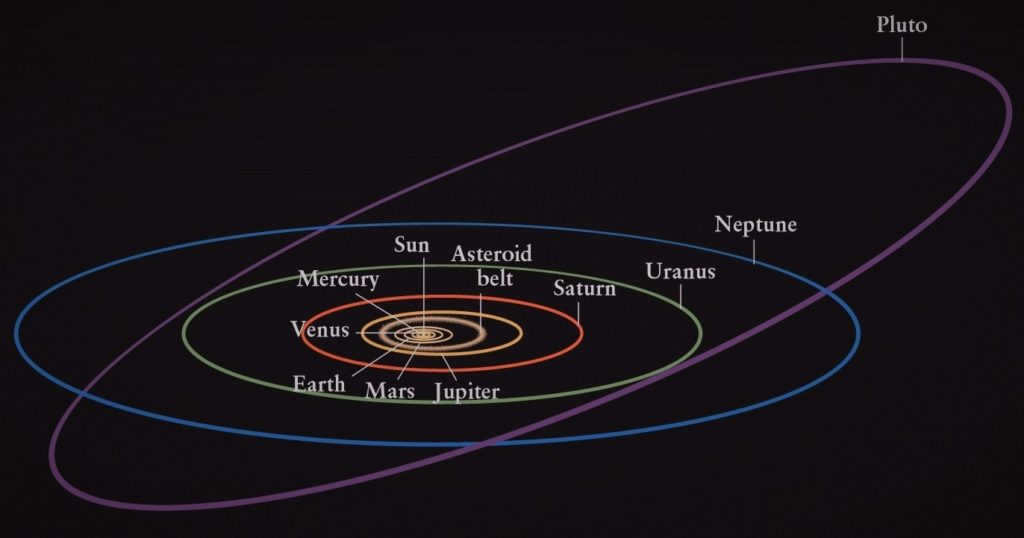

Pluto’s path around the Sun has a stretched out oval shape. It takes 248 years for Pluto to complete one full revolution around the star. Throughout this time, the distance between Pluto and the Sun constantly changes: it gets closer at 30 a.u. (astronomical units) and then moves further away to 39 a.u., with 1 a.u. being equivalent to 150 million kilometers. Compared to the other planets, Pluto’s rotational plane is tilted at an angle of 17 degrees.
Composition of the interior
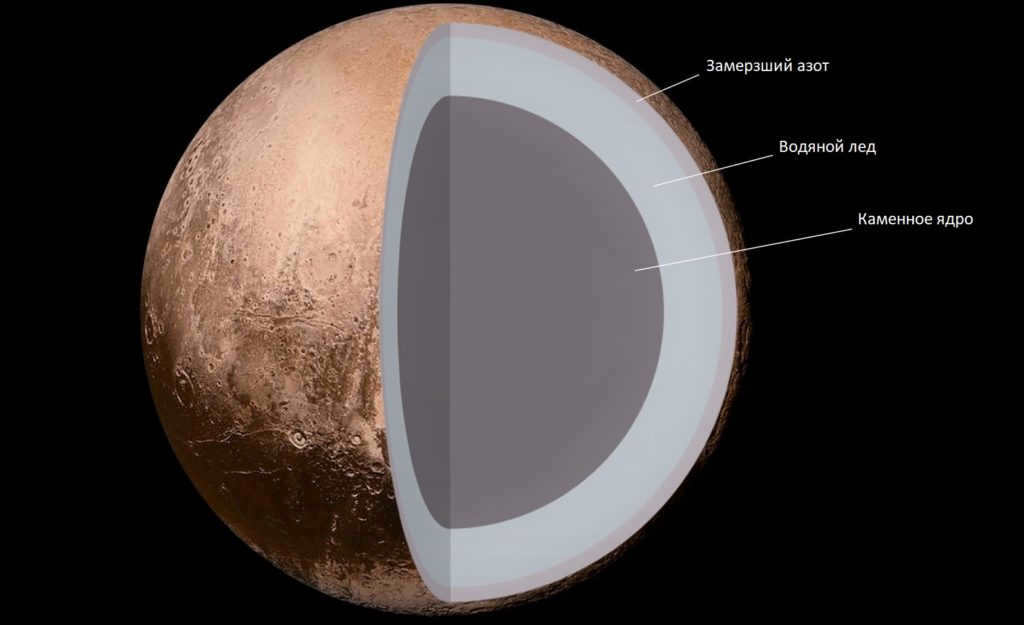
The makeup of Pluto consists of three primary elements:
- The planet’s atmosphere is composed of a thin layer of methane, nitrogen, and carbon monoxide.
- Beneath the atmosphere lies a 250-kilometer-thick mantle composed of water and ice.
- The planet’s core, measuring 1772 kilometers in diameter, is a combination of rock and ice.
These conclusions are speculative and based on spectral analysis, as Pluto remains relatively understudied.
Fascinating fact: The ice on Pluto is significantly more durable than hardened steel and accounts for one-third of the planet’s composition.
Characteristics of the Atmosphere and Surface
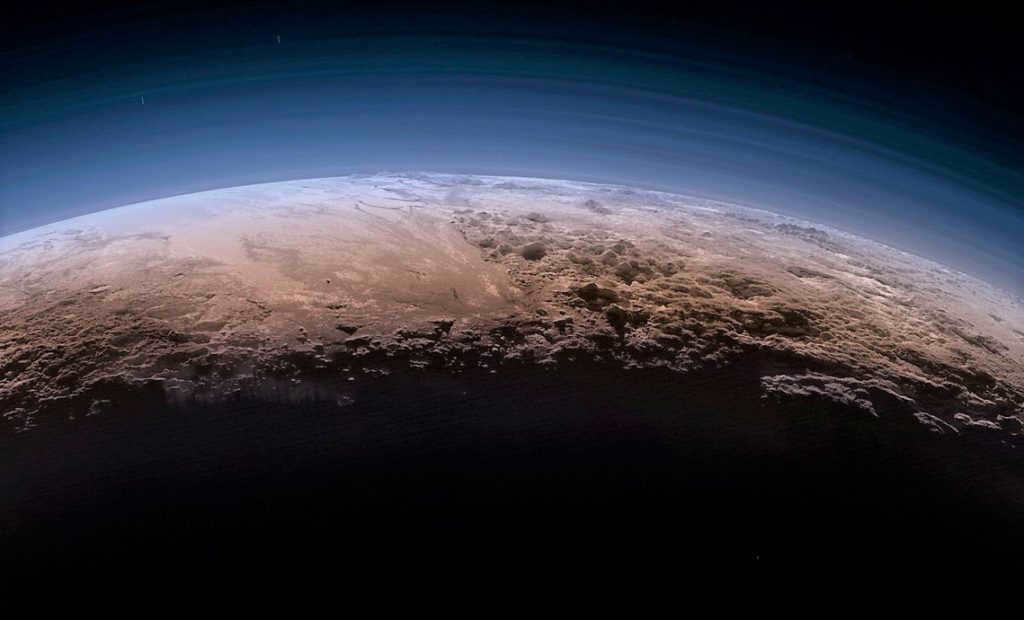

Despite the fact that the majority of Pluto’s surface is covered with ice, advanced telescopes have observed a diverse range of colors on its surface. The captured images have unveiled the following:
In 2015, scientists discovered a frozen mountain range composed of a mixture of methane, nitrogen, and carbon monoxide. Pluto possesses a gaseous atmosphere, with nitrogen being the dominant element. Methane and carbon monoxide are present in smaller quantities. With this composition, the possibility of life, even in its most basic form, is excluded.
When Pluto is closest to the Sun, the ice undergoes a transformation into a gaseous state. Upon moving away from the celestial body, it crystallizes and settles on the surface, forming a distinct crust.
Nevertheless, the temperature conditions vary across different regions. Methane has the ability to generate a greenhouse effect, resulting in a slight increase in temperature at certain altitudes above the surface, typically by 10 – 20 degrees Celsius.
Color
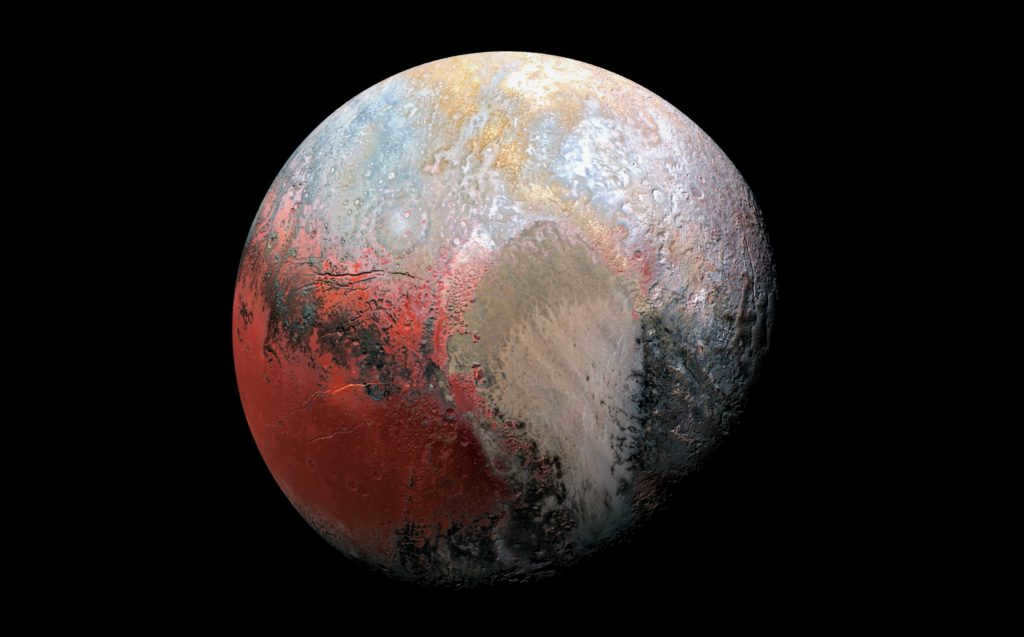
Prior to 2015, there were mere speculations regarding the hue of Pluto’s exterior. Given the predominance of ice on the planet, one would anticipate a corresponding color scheme: white with hints of gray and light blue. However, upon examination of telescope photographs, an entirely distinct palette becomes evident: a pale yellow hue that occasionally transitions into deeper shades.
Does life exist on Pluto?
Pluto lacks the necessary conditions for the emergence of life:
- its significant distance from the Sun;
- the extremely low temperature, causing water, methane, nitrogen, and carbon monoxide to freeze;
- the surface pressure is more than a million times lower than that of Earth;
- the presence of a gaseous atmosphere;
- a surface covered in an icy crust.
The atmosphere on Pluto is in constant flux, depending on its proximity to or distance from the Sun. In such an inhospitable environment, the possibility of life originating, let alone existing, is highly unlikely.
Here’s an intriguing fact: If a person weighs 90 kilograms on Earth, they would weigh only 5.5 kilograms on Pluto.
Moons of Pluto
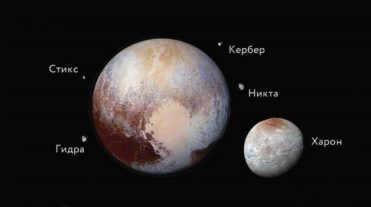
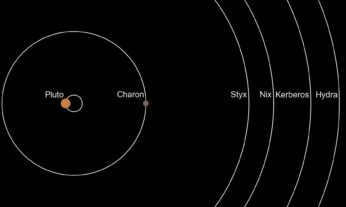
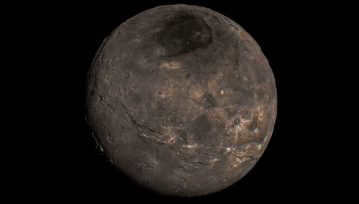
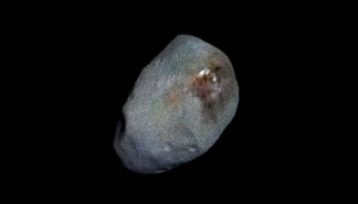
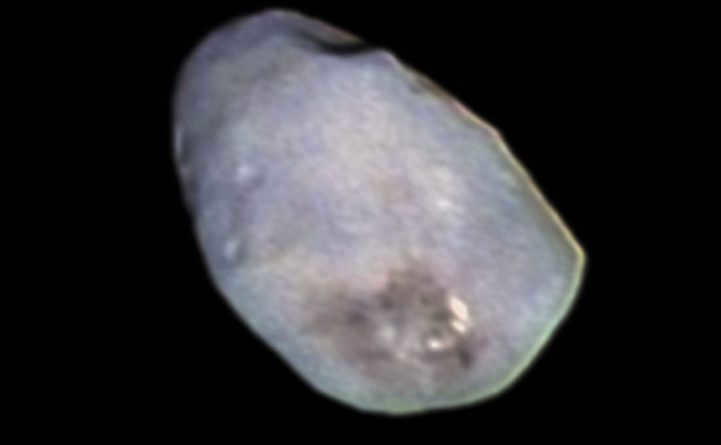
- Charon was first discovered in 1978 and is half the size of Pluto, with a diameter of 1212 km. It has a significantly different composition and is believed to be a fragment of the planet itself, ejected during a collision. As a result, Charon has more modest dimensions.
- Nicta was discovered in 2005 by the Hubble telescope and initially had a diameter of 45 kilometers. It orbits at the same speed as Charon and is in a resonance ratio of 3:2 with Hydra. The duration of one revolution around Pluto is 25 days.
- Hydra was discovered in 2005 and is located 65,000 kilometers away from Pluto. Its diameter varies from 40 to 60 km based on brightness level, and it takes 32 days to complete one orbit. While there is no data on the composition of this satellite, it is suggested to have an icy mantle and a rocky core.
- Kerber was first discovered in 2011 and is located between Hydra and Nykta. It is believed that Kerber formed as a result of a collision between Pluto and a larger cosmic body. Kerber has a diameter of 13-34 km, a major semi-axis of 59,000 km, and an orbital period of 32 days.
- Styx was discovered in 2012 and is the smallest of the five moons. It is located 58,000 miles away from Pluto and has a diameter of 10-25 km. Styx completes one revolution in 19 days and has a major semi-axis of 42,000 km. Other physical characteristics of Styx have not yet been determined.
Interesting fact: Some astronomers consider the Pluto-Haron system to be a double planet because both bodies orbit around the same point of the center of mass of the system.
What is the duration of a flight to Pluto?
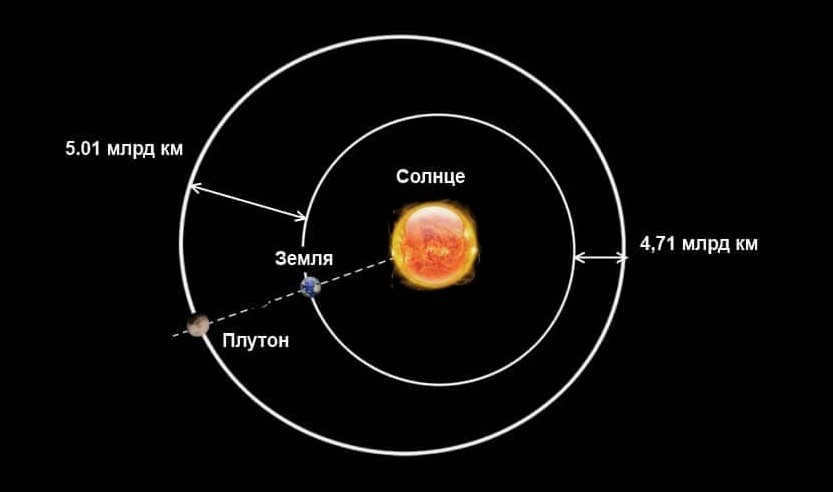
The velocity of light is approximately 300,000 meters per second. It would require 4.6 hours for light to traverse the distance from Pluto to Earth. The New Horizons spacecraft had a velocity of 58,000 kilometers per hour, which is twice the typical acceleration for similar vehicles. The computation of the duration of the journey is straightforward: the spacecraft was launched in 2006, and it reached its closest approach to Pluto in 2015. To be more precise, the journey lasted 9 years, 5 months, and 24 days.
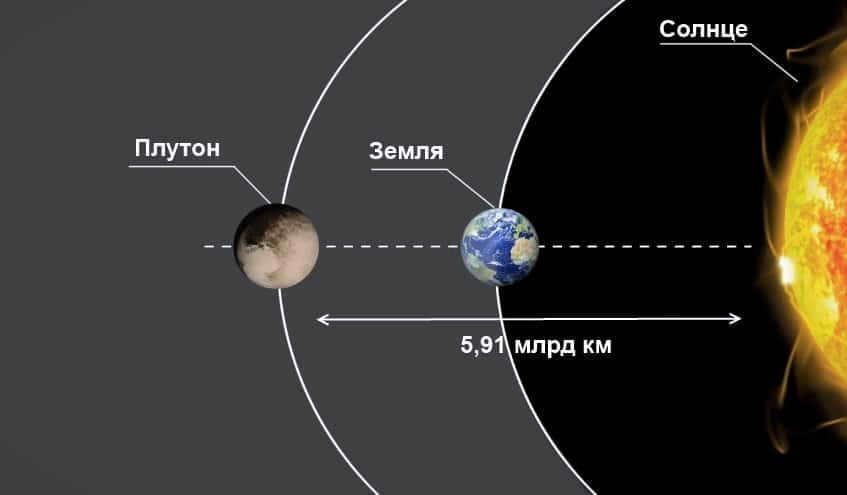
According to Earth’s measurements, the distance between Pluto and the third planet from the Sun is 4.4 billion kilometers or 29 astronomical units. However, when considering the maximum approach, this distance increases to 7.3 billion kilometers or 49 a.u. This calculation takes into account the orbital inclination of 17 degrees. Taking all these factors into consideration, the average distance is determined to be approximately 5.91 billion kilometers or 40 a.u.
Did you know? It takes approximately 5 hours for sunlight to reach Pluto, whereas it only takes 7 minutes to reach Earth.
Discovery History
Urbain Leverrier, a French mathematician who specialized in celestial mechanics, conducted an analysis of Uranus’ orbit. Through his observations, he noticed certain disturbances that indicated the presence of an unidentified planet nearby. In 1894, Percival Lowell, an American businessman, astronomer, and mathematician, established an observatory using his own finances. He also initiated a project dedicated to the search for the ninth planet. Despite the efforts, the research remained fruitless. Numerous celestial bodies were captured in photographs by enthusiasts, but the elusive planet remained unseen.

Clyde Tombaugh, an American astronomer, made the remarkable discovery of Pluto on February 18, 1930. While working at the observatory, he captured photographs and astutely noticed a celestial object in motion within the images. This discovery was later identified as Pluto through a simple animation of several photo cards. The Lowell Observatory officially announced the finding of this new planet on March 13 of the same year.
What is the reason behind the name “Pluto”?
When astronomers discovered the ninth planet, they faced the question of what to name it. Traditionally, the honor of naming a newly discovered planet went to the discoverer. However, in this case, the naming rights were given to the institution where the discoverer, Clyde Tombaugh, worked – the Lowell Observatory. It was Constance, the late wife of Percival Lowell, who made several suggestions for the planet’s name. Initially, she proposed naming it after her husband, calling it “Percival.” Then, she suggested naming it after the Roman god Zeus. Finally, she even proposed naming it after her own name. However, the scientific community did not pay attention to her suggestions.
The name “Pluto,” which is currently used, was actually coined by a regular schoolgirl from Oxford named Venetia Burney. She came up with the name because Pluto is a god from ancient Roman mythology who was believed to rule the underworld. This name perfectly suited the cold and gloomy surface of the newly discovered planet.
The girl shared her idea with her grandfather, who was currently employed at Oxford University’s library. He then forwarded the suggestion to Professor Turner, who subsequently reached out to his colleagues in the United States. A total of three options were put forth: “Minerva,” “Kronos,” and “Pluto.” The first two were ultimately dismissed, and the planet received its official name on May 1, 1930.
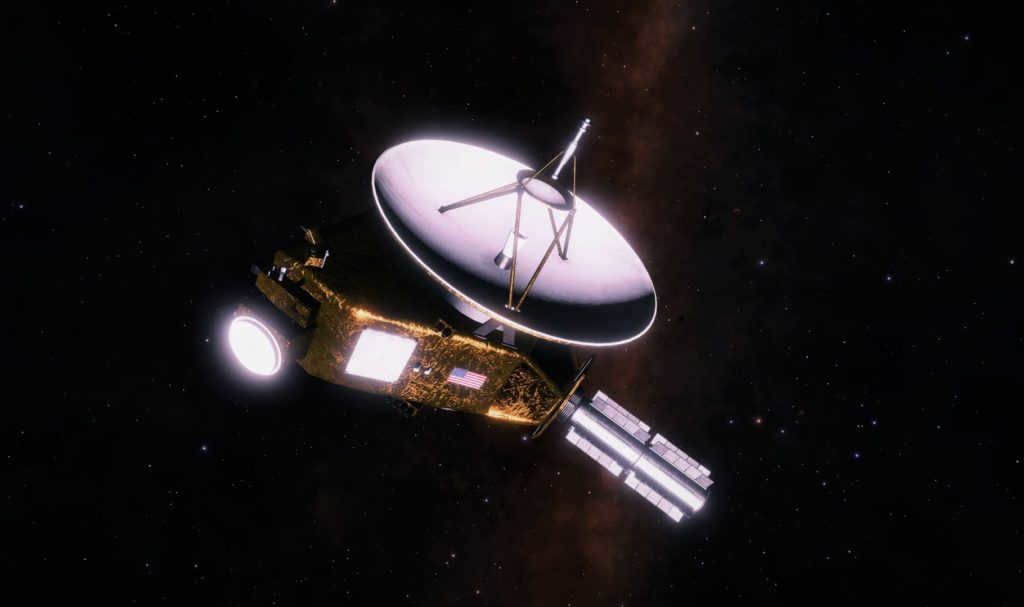
Between 1906 and 1916, American scientists initially discussed the accidental finding of a new planet, the ninth one, which they named “Planet X”. Further investigation followed in the following sequence:
The equipment provided data that allowed for a spectral analysis of the planet’s surface. Over time, various images were captured, enabling comparisons of geological activity.
Initially, it was believed that there would be rings around Pluto, which could have formed as a result of collisions. As the New Horizons satellite approached the planet, it transmitted photos back to Earth. However, no rings were observed in the photos, and it was determined that the satellite would have inevitably collided with them. After a thorough analysis of the collected data, scientists unanimously agreed that there are no rings present around the planet.
The Current Status of Pluto
Pluto was officially recognized as the ninth planet from the Sun in 1930. However, its status as a planet was later revoked due to concerns about its size and characteristics. After extensive research, scientists reclassified Pluto as a dwarf planet. This decision was made in 2006 after much debate and consideration of several criteria for planetary status:
- The celestial body must orbit the Sun and be a satellite of a star, rather than a planet.
- The object must have enough mass to assume a spherical shape under the influence of gravity.
- The body’s size should be sufficiently large to not have any objects larger than it within its orbit, except for its satellites or objects influenced by gravity.
- Therefore, scientists concluded that Pluto cannot be classified as a planet due to the third criterion. Being located in the Kuiper belt, its mass was compared to that of nearby objects. It was found that Pluto has only 7% of the mass of other celestial bodies.
By taking these factors into account, scientists determined that Pluto does not meet the criteria to be considered a planet. Its location in the Kuiper belt and its relatively low mass compared to other objects in the area led to this conclusion.
Other celestial bodies of small size
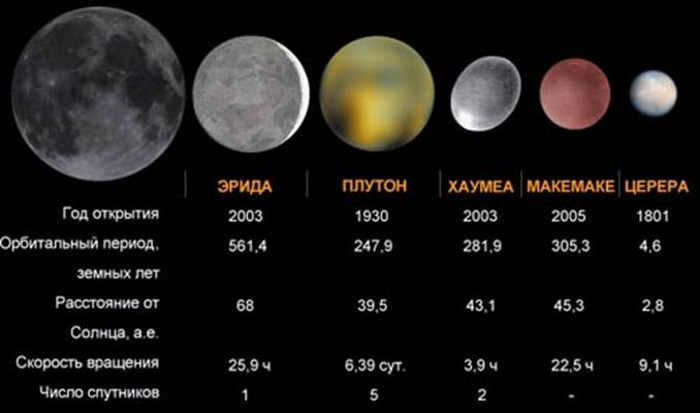
Pluto was included in the category of dwarf planets and classified as a plutoid because it met the first two criteria. Plutoids are spherical celestial bodies with a small mass that orbit around the Sun. However, their orbit must have a larger radius than Neptune’s. Besides Pluto, other plutoids include Erida, Makemake, and Haumea.
Fascinating fact: On Pluto, a day is equivalent to six Earth days, and it takes a whopping 248 Earth years for Pluto to complete one full rotation around the Sun.
Pluto is officially classified as a minor planet with the designation 134340 (September 7, 2006). It is worth noting that if scientists had initially categorized this celestial body accurately, it would have been listed among the first thousand in the catalogue. The only distinguishing factor between a standard planet and a dwarf planet lies solely in the size of the objects. In all other aspects, they are identical.
If you come across any mistakes, kindly select the specific text and press Ctrl+Enter to report it.
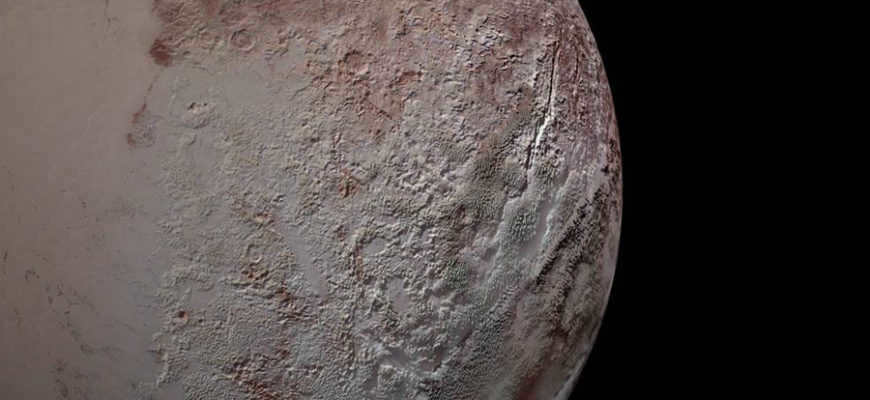

The solar system
Pluto is the biggest dwarf planet in the solar system. This distant and mysterious world used to be considered the 9th largest planet alongside Jupiter, Mars, Saturn, and Earth. However, in 2006, astronomers decided to reclassify Pluto as a dwarf planet.
Pluto is located in the Kuiper Belt, a region in space that is beyond Neptune’s orbit. The Kuiper Belt is home to numerous icy and rocky objects that are over 100 kilometers in diameter, as well as potentially hundreds of billions of comets. Currently, Pluto is the largest known object in the Kuiper Belt.
Since the latter half of the 19th century, astronomers have had suspicions about the presence of a mysterious planet beyond Neptune’s orbit. In order to locate this enigmatic planet, scientists needed to calculate its precise position in the celestial sphere. Their only resources for this task were slight variations in the movements of Uranus and Neptune and the power of mathematics. Percival Lowell, an American entrepreneur and astronomer, played a significant role in this endeavor. From 1905 to 1915, he identified specific regions of the sky where this unknown planet might exist. The Lowell Observatory team embarked on their initial search in 1906, but unfortunately, it proved unsuccessful.
Pluto was first spotted by astronomer Clyde Tombaugh in 1930 at the observatory that Percival Lowell had funded. (Lowell had passed away in 1915.) Tombaugh dedicated close to a year to specifically searching for the planet, meticulously examining photographs of different areas of the night sky on a daily basis. Eventually, he successfully located the elusive planet. It appeared as a dim star that exhibited movement in relation to the surrounding stars.
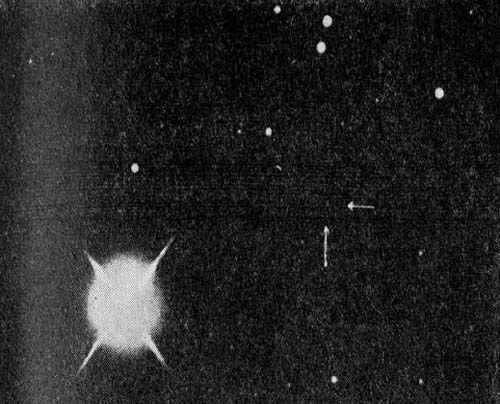
The planet Pluto received its name from the Roman god of the underworld, Pluto, who is also known as Hades. This moniker was proposed by an English girl named Venetia Burney when she was just 11 years old. The choice of name proved to be quite fitting, considering that Pluto resides in the fringes of our solar system, where perpetual darkness prevails.
- Pluto is a small celestial body primarily composed of frozen substances. It has a diameter of 2376 km, which is equivalent to the distance from Moscow to Omsk.
- The average distance from the Sun to Pluto is approximately 5.8 billion kilometers, making this dwarf planet 40 times farther from the Sun than Earth.
- A single year on Pluto is equivalent to 248 Earth years, representing the time it takes for the planet to complete one orbit around the Sun.
- A day on Pluto lasts approximately 6.4 Earth days, which is nearly an entire week!
- Pluto possesses a very thin atmosphere consisting mainly of nitrogen, methane, and carbon monoxide. As Pluto moves farther away from the Sun along its elongated orbit, the atmosphere almost entirely freezes, descending onto the surface as frost.
- Pluto has recently been discovered to possess five satellites. The largest of these, Charon, is merely half the size of Pluto. This is why the Pluto-Charon system is commonly referred to as a binary planetary system.
- Pluto’s surface is characterized by expansive icy plains that are nearly devoid of craters. One notable example is the Sputnik Plain. These plains seem to have formed relatively recently, approximately 100 million years ago. This observation suggests that Pluto is currently experiencing geological processes.
- Throughout its existence, only one human-made spacecraft has ever ventured to Pluto – NASA’s “New Horizons” probe. This historic event took place during the summer of 2015.
What is the appearance of Pluto?
Due to its considerable distance from Earth, astronomers had long struggled to provide accurate descriptions of Pluto’s characteristics. They could only make rough estimates of its size and mass, which were highly unreliable. Furthermore, there was a complete lack of data regarding Pluto’s composition. It was not until the late 1970s, following the discovery of its moon Charon, that astronomers began to gain insights into the structure of this celestial body. A comprehensive understanding of Pluto’s appearance was only achieved relatively recently, in 2015, when NASA’s New Horizons spacecraft conducted a close flyby of the planet.
The photos obtained by the probe reveal a fascinating view of Pluto’s surface. The images showcase a diverse range of landscapes, including towering mountains reaching heights of up to 3.5 kilometers, extensive mountain ranges, craters, and expansive icy plains. The majority of the surface is covered in ice, primarily composed of methane and nitrogen. It is the nitrogen ice that imparts the planet’s distinctive reddish hue. Interestingly, both methane ice and nitrogen ice lack the strength necessary to form such lofty mountains. Astronomers propose that these mountains are actually composed of regular water ice.
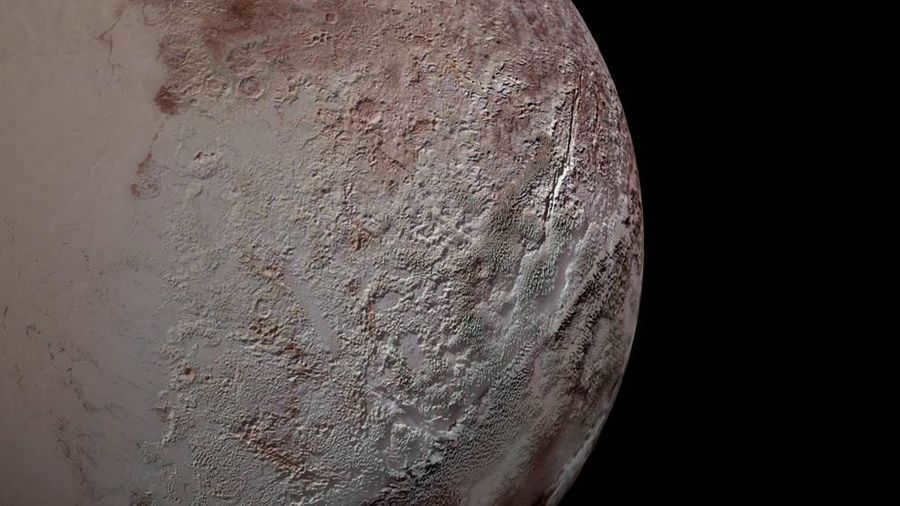
Physical characteristics of Pluto
Pluto's size
Pluto’s measurements have been taken to the nearest 3 kilometers. The planet has a diameter of 2376 ± 3 kilometers. This is significantly smaller than any of the planets in the solar system, including Mercury, and even smaller than the Moon’s diameter!
Pluto is more than 5 times smaller than Earth. It is quite challenging to classify such a compact object as a large planet.
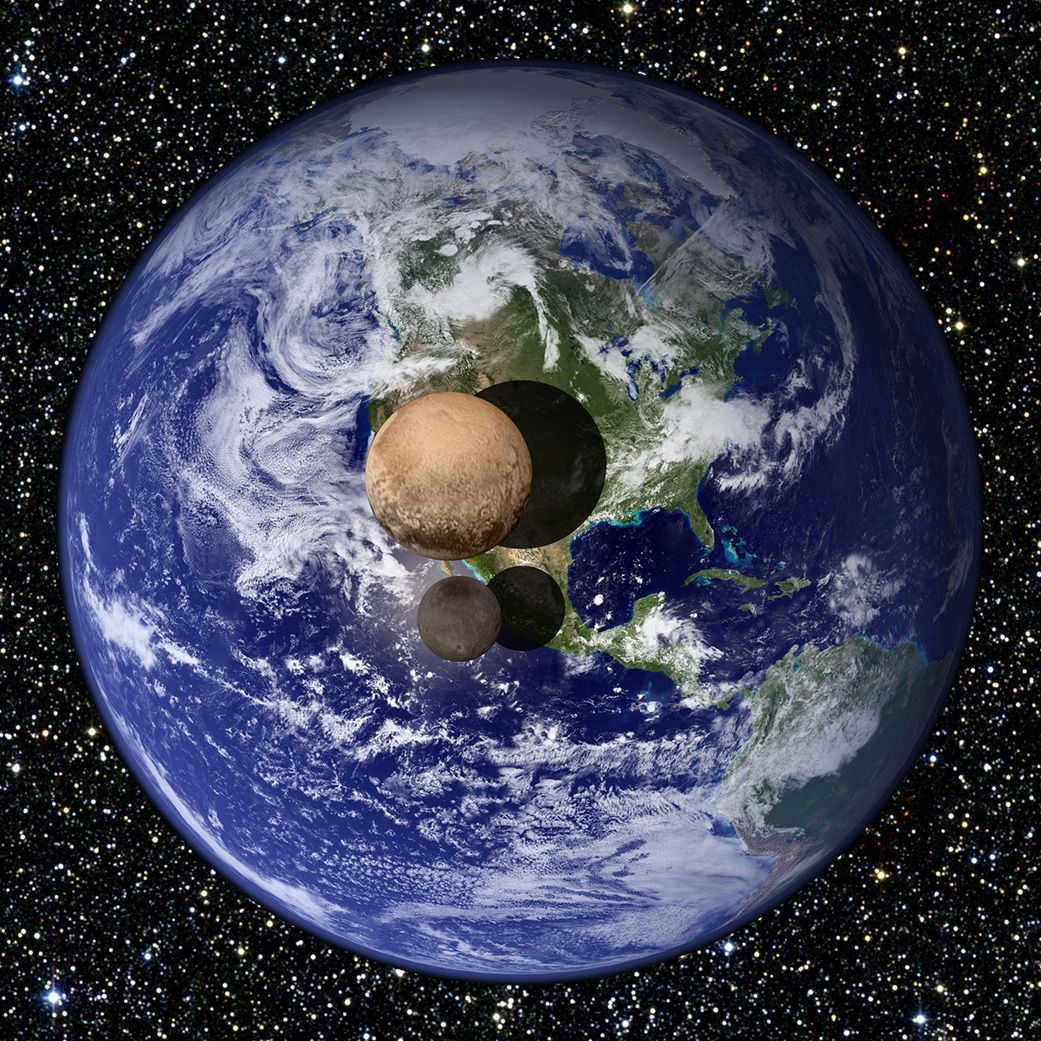
Mass of Pluto
During the early 20th century, astronomers predicted that the planet located beyond the orbit of Neptune would have a greater mass than Earth. However, upon the discovery of Pluto, it was found to be too dim to be such a large planet. From 1930 to 1978, the estimated mass of Pluto gradually decreased from being equal to one Earth mass to being only one-tenth the mass of our planet, similar to Mars.
In 1978, the discovery of Pluto’s satellite enabled scientists to accurately determine the planet’s mass. It was revealed that Pluto is approximately five times lighter than the Moon and 400 times lighter than Earth!
The dwarf planet has a volume of 7,000,000,000,000,000,000 km³, which is equivalent to 7 billion cubic kilometers. This is approximately 155 times smaller than the volume of our planet. Therefore, the Earth could fit as many as 155 Pluto’s inside it!
What is the composition of Pluto?
If we divide the planet’s mass by its volume, we can determine its average density. The average density provides insight into the planet’s composition. For instance, Mercury and Earth have densities exceeding 5 g/cm³. This suggests that these planets are primarily composed of metals and rock. On the other hand, Jupiter and Saturn have densities of only about 1 g/cm³ – indicating that they are gas giants.
Pluto, on the other hand, has an average density of 1.86 grams per cubic centimeter. This falls between the densities of gas giants like Jupiter and rocky planets like Earth. The composition of Pluto is greatly influenced by various ices.
Pluto’s Composition and Inner Structure
Approximately 30 to 50% of Pluto’s total mass is believed to be made up of ice. This icy layer, known as the mantle, is predominantly composed of water ice. On the other hand, the crust and surface of Pluto are comprised of more unique and exotic ices such as nitrogen, carbon monoxide, and methane. The remaining 50 to 70% of the planet’s mass is concentrated in its core, which consists of rocky materials. The core has a diameter of approximately 1700 kilometers. It is also speculated that beneath Pluto’s icy outer layer, there may exist a vast subterranean ocean of liquid water. This potential water reservoir is thought to be heated by the radioactive decay of substances deep within the dwarf planet’s interior.
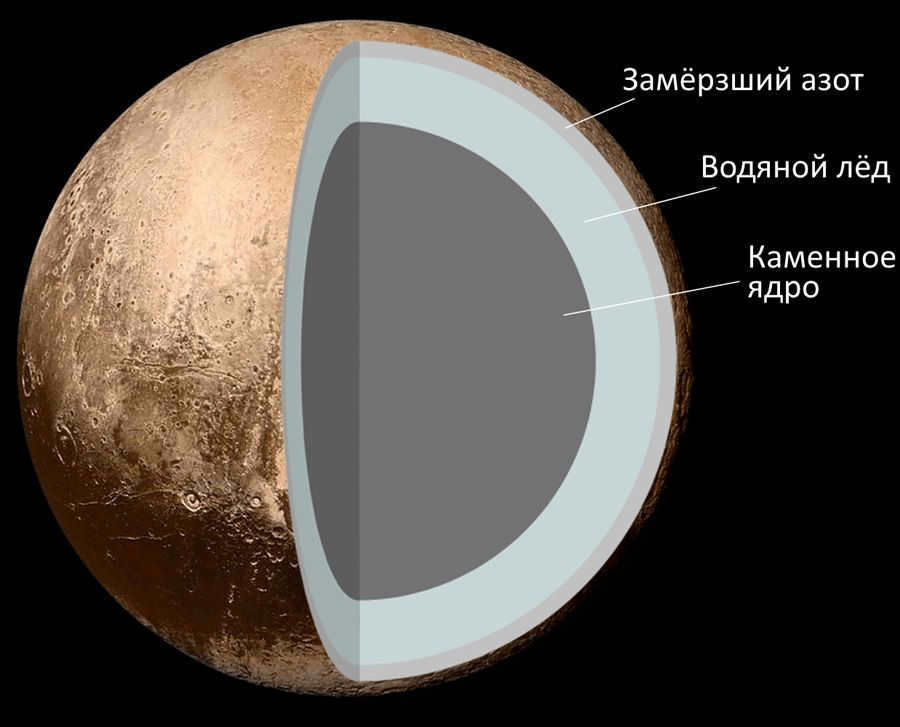

Composition of substances
Pluto seems to consist of 70% rock (rocks, basalts) and 30% water.
Magnetism
During its flyby of Pluto, the New Horizons station attempted to detect the planet’s magnetic field but was unsuccessful. The small size of the dwarf planet and its slow rotation on its own axis suggest that such a field may not be present.
Composition of the Atmosphere
The atmospheric makeup of Pluto consists mainly of nitrogen, making up 99% of its composition. The remaining 1% is a combination of methane, carbon monoxide, and various hydrocarbons such as acetylene and cyanogen. It is interesting to note that the pressure at the surface of Pluto is significantly lower than that of Earth, measuring at only 1 Pascal. This is a staggering 100,000 times less than what we experience on Earth. However, despite this low pressure, Pluto’s atmosphere still manages to produce a haze that extends to an altitude of 200-300 kilometers. For more information on this topic, please refer to the article on Pluto’s Atmosphere.
Pluto’s path around the Sun
Pluto revolves around the Sun in a path that bears resemblance to the paths of the more massive planets in our solar system. The major planets all follow a similar trajectory, known as the ecliptic plane, and Pluto’s path deviates from it by 17 degrees. Furthermore, Pluto’s path is not perfectly circular but rather elongated, taking on an oval shape rather than a perfect circle.
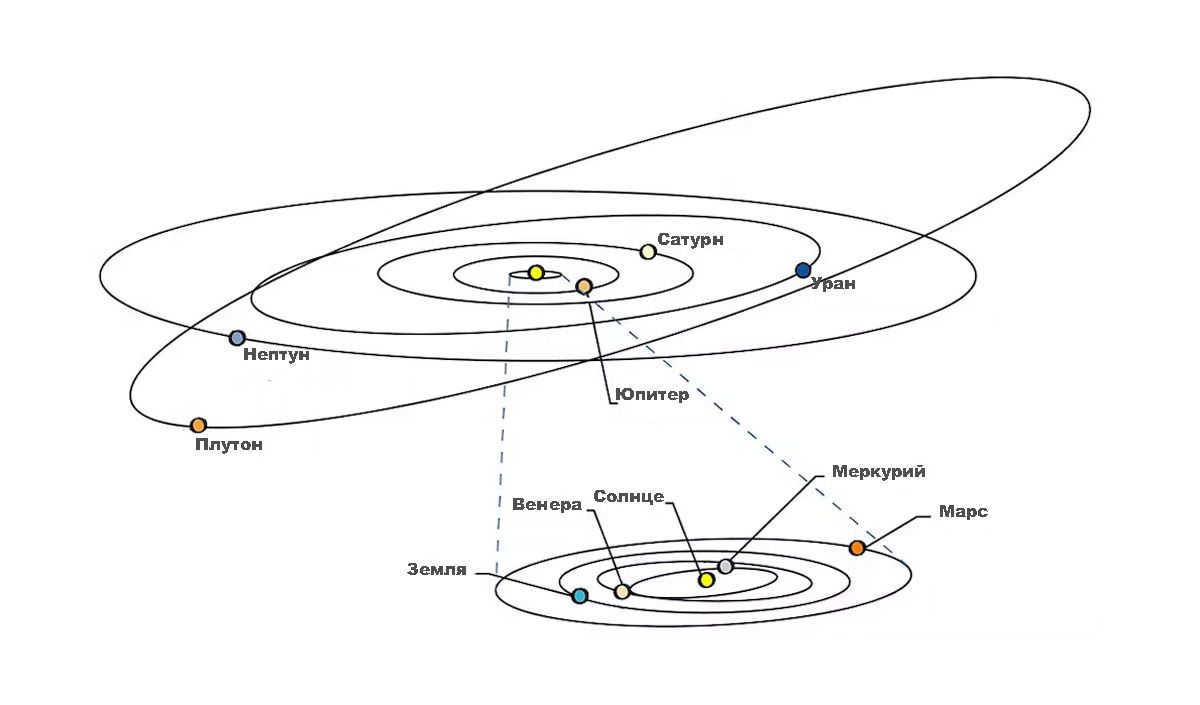

Due to its elongated, or highly elliptical, orbit, Pluto moves 49 astronomical units away from the Sun (1 a.e. being the average distance from Earth to the Sun, approximately 150 million kilometers), and then approaches 30 a.e. As a result, the dwarf planet occasionally comes closer to the Sun than Neptune. This occurrence occurs only once every 20 years during Pluto’s 248-year revolution.
The most recent occasion when Pluto was closer to the Sun than Neptune was between 1979 and 1999. At that time, Pluto was officially recognized as the eighth planet from the Sun, while Neptune was considered the ninth. (Pluto was not classified as a dwarf planet until 2006.)
It is important to mention that the planet has a very slow orbit. Pluto’s average orbital speed is only 4.67 km/s, which is six times slower than Earth’s orbital speed. At perihelion, Pluto reaches its maximum speed of 6.1 km/s, while at aphelion, it reaches its minimum speed of 3.71 km/s.
Orbital Characteristics of Pluto
Here is a comparison of Saturn’s orbit, velocity, and axial rotation period with that of Earth.
| Orbital semi-major axis (million kilometers) | 5869.656 | 149.598 | 39.236 |
| Sidereal orbital period (days) | 90560 | 365.256 | 247.94 |
| Tropical orbital period (days) | Unknown | 365.242 | — |
| Perihelion (million km) | 4434.987 | 147.095 | 30.15 |
| Aphelion (million km) | 7304.326 | 152.1 | 48.023 |
| Synodic period (days) | 366.73 | — | — |
| Average orbital velocity (km/s) | 4.67 | 29.78 | 0.157 |
| Max. Orbital velocity (km/s) | 6.1 | 30.29 | 0.201 |
| Min. Orbital velocity (km/s) | 3.71 | 29.29 | 0.127 |
| Orbital inclination (deg.) | 17.16 | 0 | — |
| Eccentricity | 0.2444 | 0.0167 | 14.635 |
| Stellar day (period of rotation around its axis, h) | -153.2928 | 23.9345 | 6.405 |
| Solar day (h) | 153.282 | 24 | 6.387 |
| Tilt of the equator to the orbit (deg.) | 57.47 | 23.44 | 2.452 |
Moons of Pluto
Pluto possesses a total of five moons: Charon, Hydra, Styx, Nycta, and Kerber. The nearest and most substantial of these is Charon, while the farthest and second largest is Hydra.
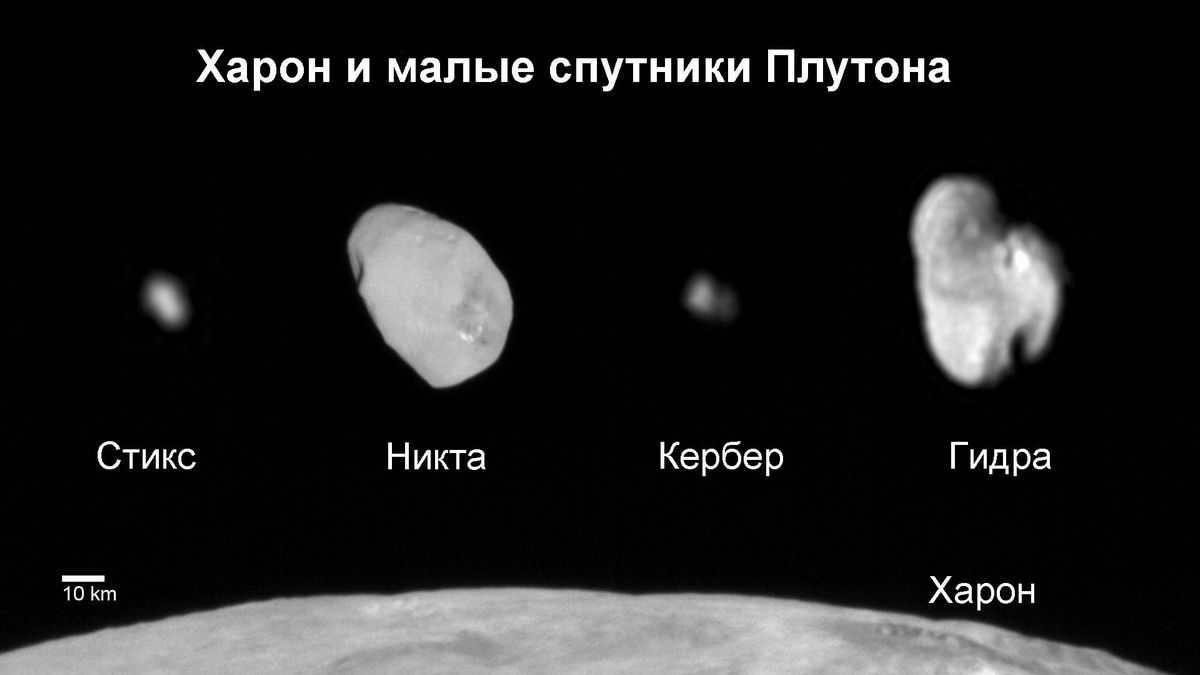
The discovery of Charon took place in 1978. It became evident right away that it was a significantly large satellite. In fact, its dimensions are just half the size of a dwarf planet. This celestial body was bestowed the name Charon, after the mythological figure that ferried the souls of the deceased to the underworld across the River Styx.
Due to their similar sizes, the orbit of Charon and Pluto differs from that of most planets and their satellites. For instance, we commonly state that the Moon orbits the Earth, although this statement is technically inaccurate. In reality, both the Moon and the Earth revolve around a shared center of mass. However, this center of mass lies within the Earth, beneath its surface, so this simplification in reasoning can be forgiven. In contrast, the center of mass of the Pluto-Charon system exists outside of Pluto. Both celestial bodies rotate around a point in space that lies between them, resembling the orbital patterns observed in double star systems.
Moons of Pluto
Pluto, the dwarf planet in our solar system, has several smaller satellites orbiting around it. Two of these satellites, named Nicta and Hydra, were first observed by the Hubble Space Telescope in 2005. They are located at a distance from Pluto that is 2 and 3 times greater than the distance of its largest moon, Charon. Nicta has a length of 42 km and a width of 32 km, while Hydra measures 113 km in length and 55 km in width.
Another moon, called Kerber, was discovered in 2011 using Hubble images. It is a very small satellite, with dimensions of 5 km by 8 km. The fifth moon, named Styx, was found in July 2012 and has an approximate size of 10 kilometers.
Exploring Pluto
Exploring Pluto presents a significant challenge due to its remote location and relatively small size. Even with the powerful Hubble Space Telescope, detailed observations of Pluto’s surface are not possible.
Fortunately, NASA’s New Horizons mission has provided valuable insights into Pluto’s surface. This groundbreaking mission marks the first and only time a spacecraft has ventured close to the dwarf planet and its moons. Launched in January 2006, the New Horizons probe successfully approached Pluto on July 14, 2015.
Interestingly, the New Horizons probe also carries a meaningful cargo – a portion of the ashes of Clyde Tombaugh, the astronomer credited with discovering Pluto.
What is the current location of Pluto in the sky?
Pluto can currently be found in the southern constellation of Sagittarius. However, in the spring of 2023, it will transition to the constellation Capricorn. After six months, it will briefly return to Sagittarius in the fall. By 2024, Pluto will permanently reside in the constellation Capricorn.
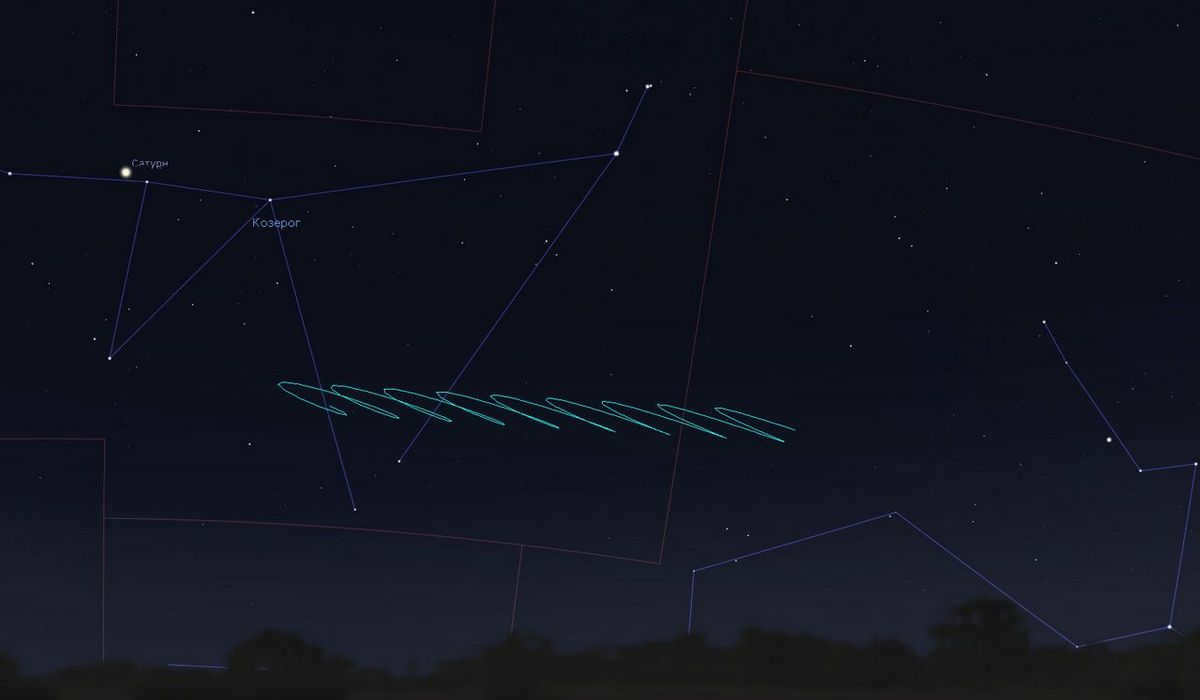

Due to its faintness, it is extremely challenging to detect Pluto using amateur telescopes.
Comparison of Pluto’s Physical Attributes to Earth
| Mass (10 24 kg) | 0.01303 | 5.9724 | 0.0022 |
| Volume (10 10 km3) | 0.702 | 108.321 | 0.0065 |
| Equatorial radius (at 1 bar) Re (km) | 1188 | 6378.1 | 0.186 |
| Polar radius Rp (at 1 bar) (km) | 1188 | 6356.8 | 0.187 |
| Average radius (km) | 1188 | 6371 | 0.186 |
| Compression (Re – Rp)/Re (km) | 0 | 0.00335 | 0 |
| Average density (g/cm³) | 1.854 | 5.514 | 0.336 |
| Gravitational acceleration (at 1 bar) (m/s²) | 0.62 | 9.8 | 0.063 |
| Free-fall acceleration (at surface) (m/s²) | 0.62 | 9.78 | 0.063 |
| Second space velocity (km/s) | 1.21 | 11.19 | 0.108 |
| GM (x 10 6 km³/s²) | 0.00087 | 0.3986 | 0.0022 |
| Spherical albedo (Bond) | 0.72 | 0.306 | 2.35 |
| Geometric albedo (visual) | 0.52 | 0.434 | 1.2 |
| Absolute stellar magnitude V | -1 | -3.99 | — |
| Solar radiation flux (W/m²) | 0.873 | 1361 | 0.00064 |
| Effective temperature (K) | 37.5 | 254 | 0.147 |
| Number of satellites | 5 | 1 | |
| Ring system | No | No |
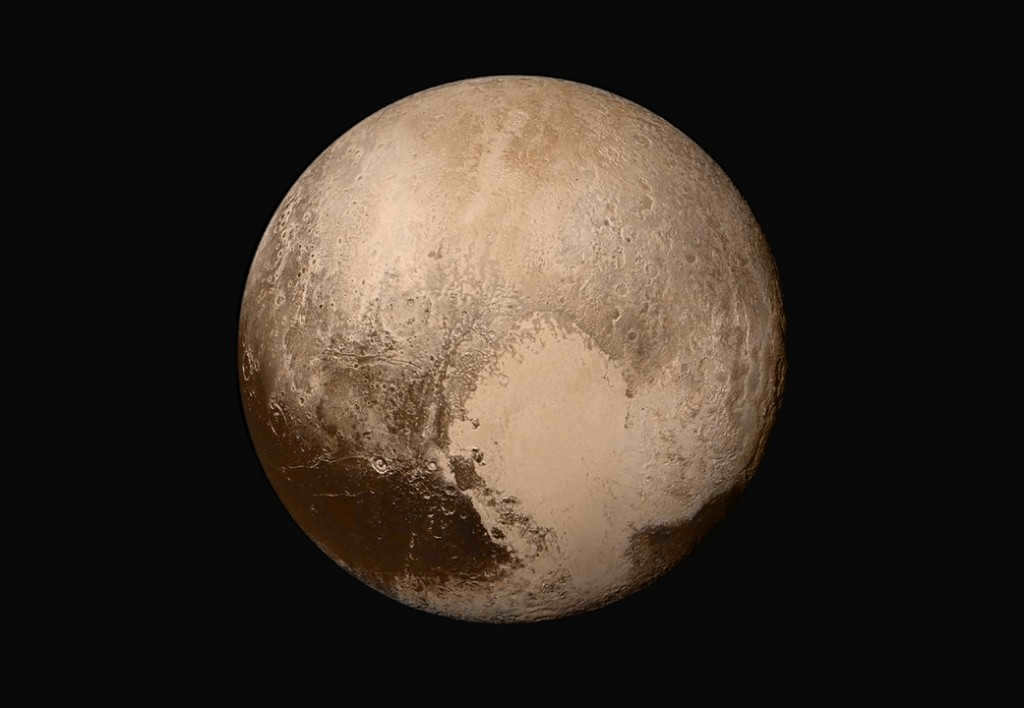
The New Horizons spacecraft has successfully transmitted photographs of Pluto and its largest satellite, Charon.
These images are unique animations that showcase new perspectives of Pluto and Charon. They were captured over a period of 6.5 days, starting on April 12 and ending on April 18, 2015. Throughout this time, the distance between NASA’s New Horizons spacecraft and Pluto decreased from approximately 104 million kilometers to 93 million kilometers.
An interesting fact is that Pluto and Charon rotate around a common center of gravity, known as the barycenter. This rotation takes place once every 6.4 Earth days.
The photographs were obtained using the LORRI camera, which was able to capture one full rotation of the Pluto-Charon system. The figure provided illustrates the direction of the rotation axis.
One of the animations showcases Pluto as the central figure with Charon orbiting around it, and this animation was artificially created. The other animation, however, accurately depicts the true nature of their movement, with both Pluto and Charon rotating around a shared center of mass.
The annotated versions of these images highlight the rotation of Pluto and Charon around the barycenter. In the lower right corner, there is a magnified inset of Pluto, three times its original size, which emphasizes the changes in brightness across its surface as it rotates.
When the New Horizons spacecraft observes Pluto, we primarily see one of its poles. This allows us to observe variations in the brightness of this dwarf planet’s disk.
The annotated version of the image also illustrates Charon’s rotation around Pluto.
Scientists have put forward a theory that the brightness observed in the polar region of Pluto could be a result of a layer of snow covering the surface. This “snow” is believed to be frozen nitrogen. The accuracy of this hypothesis will be confirmed by the observations made by the New Horizons spacecraft in July.
Furthermore, the images captured in April revealed variations in brightness as Pluto rotates. These variations are thought to be caused by the presence of dark and light spots of a larger scale on the surface of Pluto.
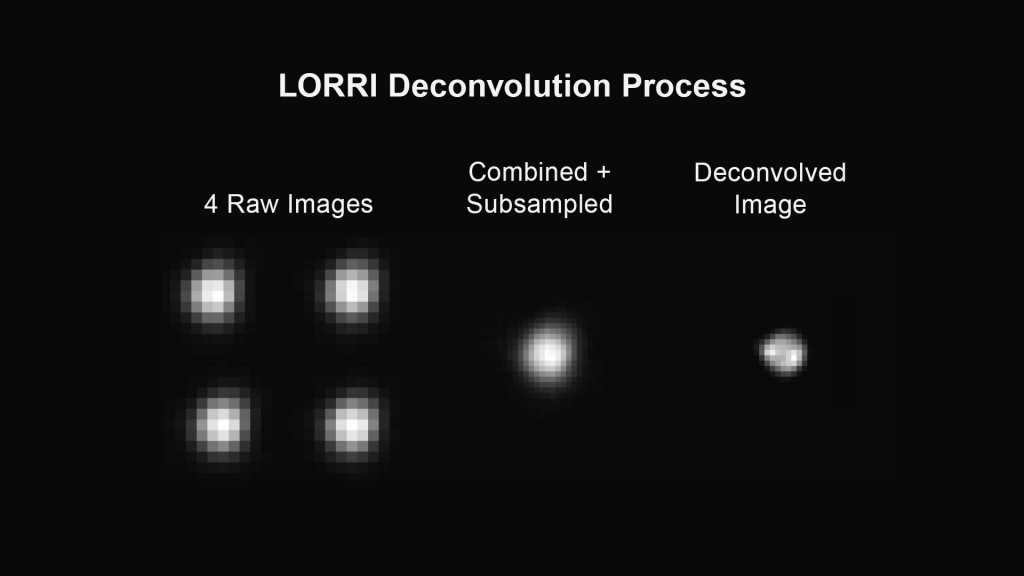
Deconvolution has been utilized to enhance the resolution of the original images captured by the Lorry camera.
From May 8 to May 14, the LORRI camera will continue to capture images of the Pluto system. Each day will consist of approximately 2-3 sessions, with 8 images taken during each session. Starting from May 15 to May 27, a variety of data sets from the New Horizons mission will be transmitted. Then, on May 28, daily observations of Pluto will commence!
Photos taken on July 12, 2015
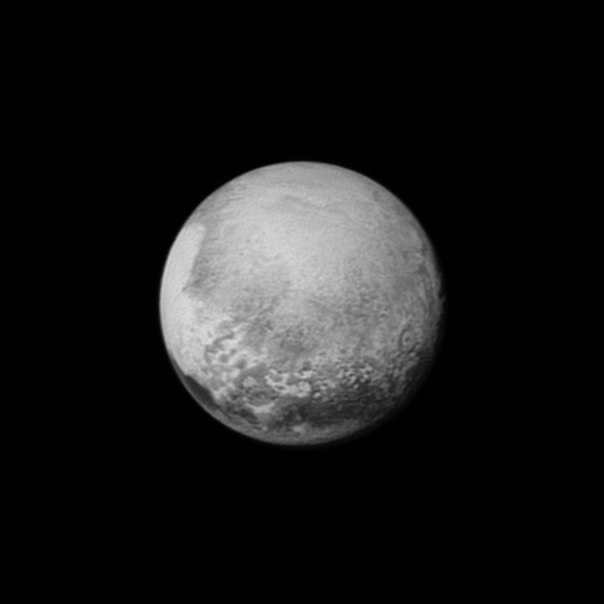
Photos taken on July 13, 2015
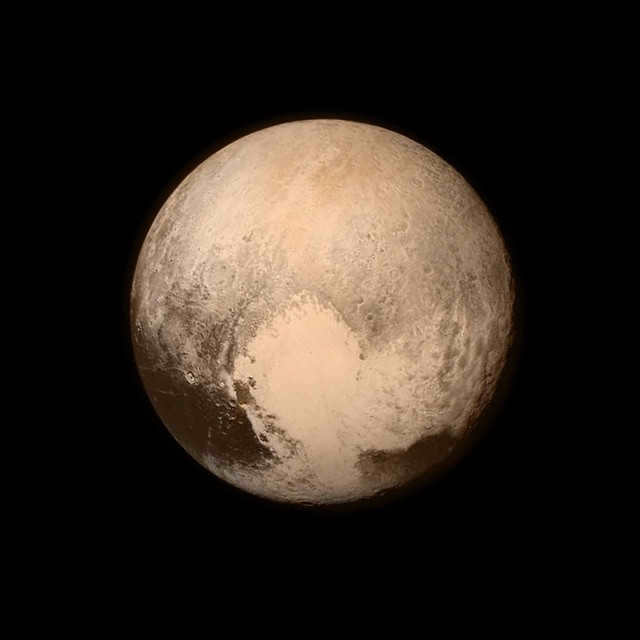
On the 13th of July, Pluto was observed from a distance of 766,000 kilometers above its surface.
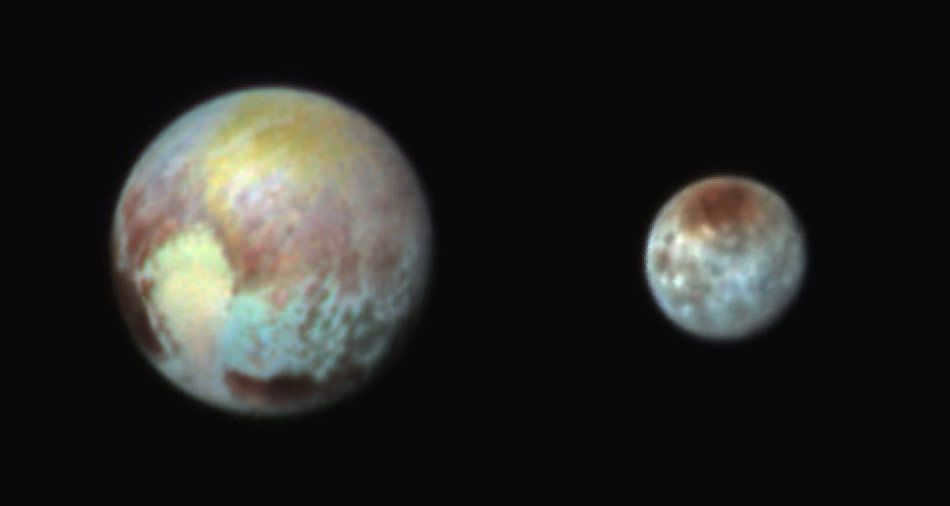

Enhanced colors were used in this image taken on July 13 to bring out the subtle details of the surface of Pluto and Charon.

Collage depicting various color images of Pluto
Photographs taken on July 14, 2015
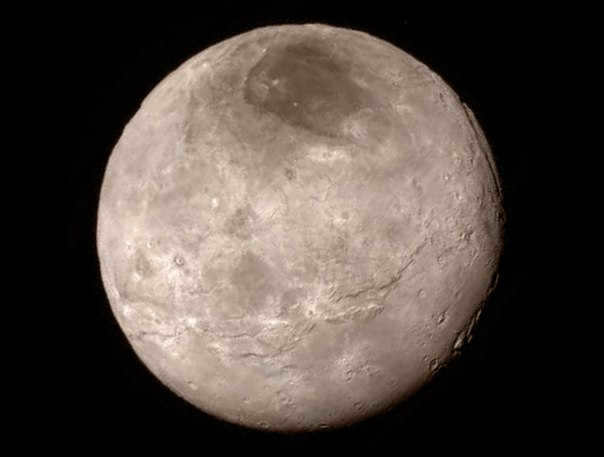
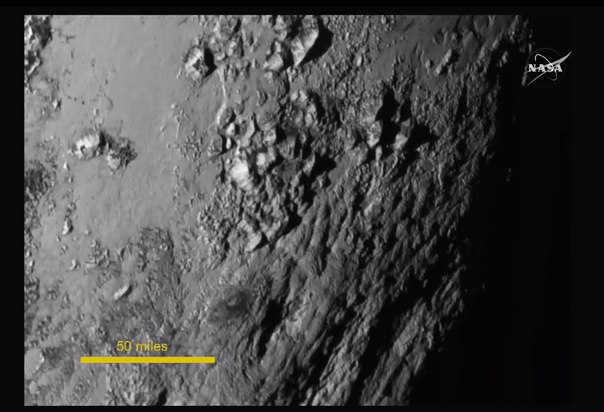
Close-up view of the surface of Pluto


Hydra, the small satellite of Pluto, has a distinctive appearance.
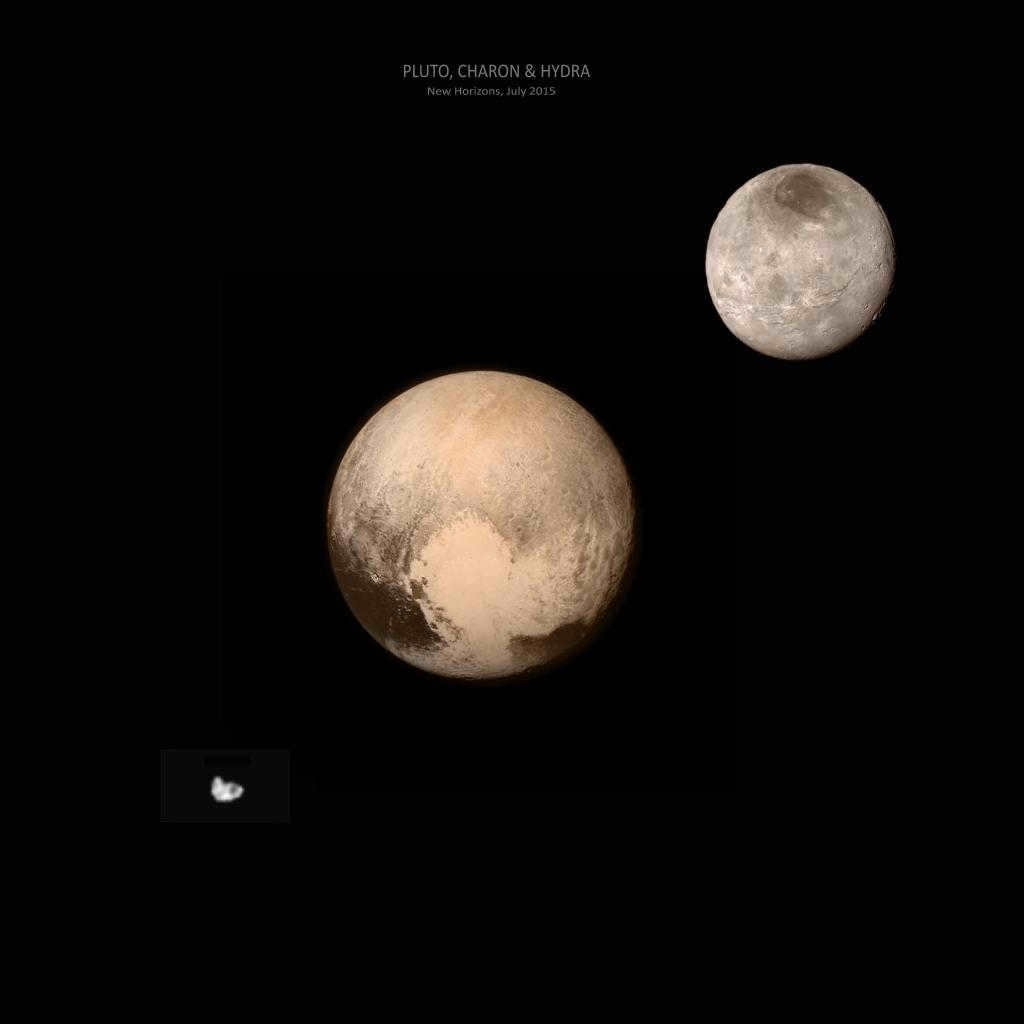
Atmosphere Composition of Pluto
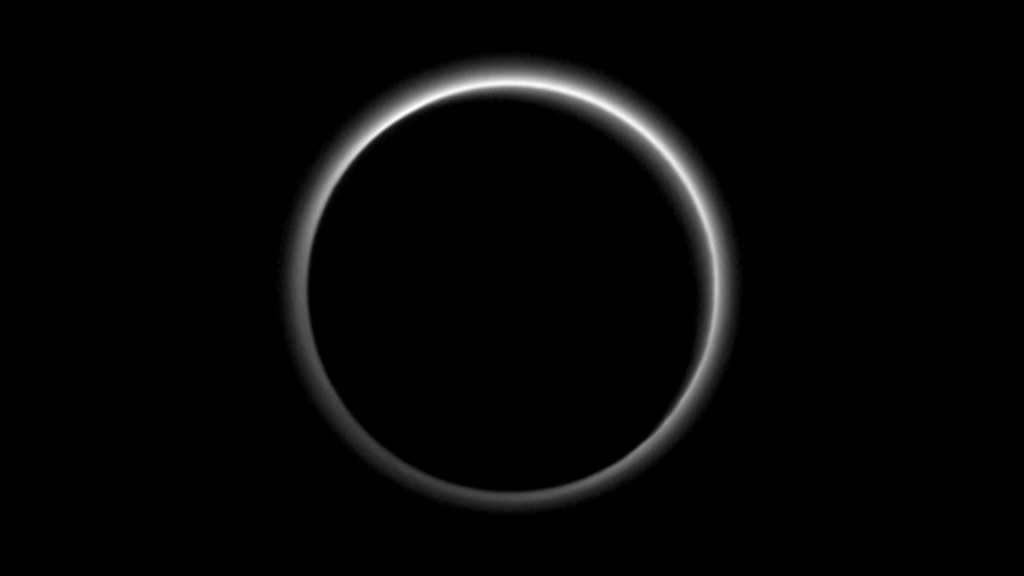
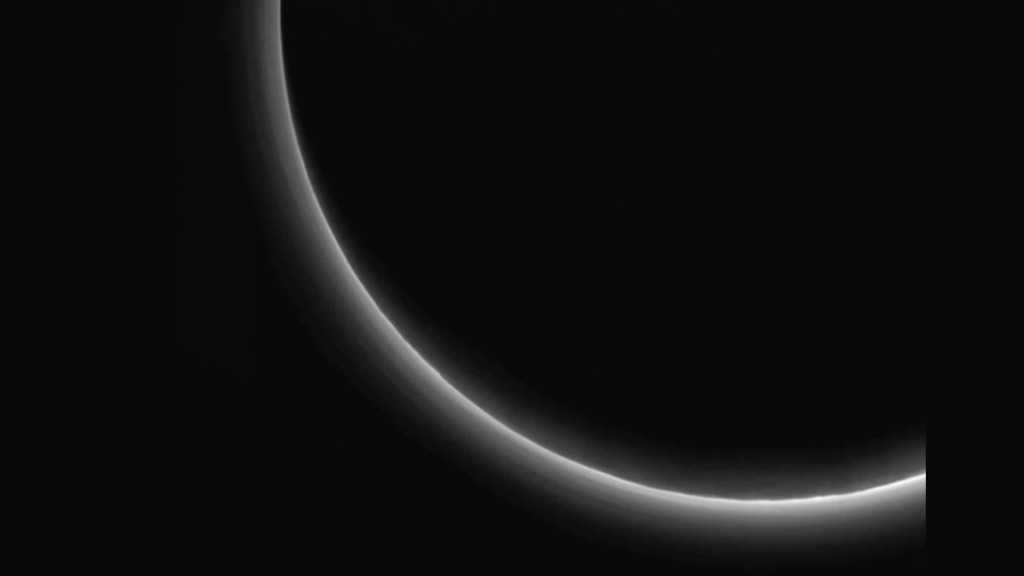
Get a close look at Pluto’s multi-layered atmosphere
Take a closer look at Pluto’s surface
Enjoyed reading this article? Share it with your friends!
Posted on April 30, 2015
Written by Maxim Zabolotsky
Pluto, previously classified as the ninth planet and the most distant one from the Sun, is now recognized as the largest dwarf planet in our solar system. It was officially identified by Clyde Tombaugh in 1930. What secrets does this enigmatic celestial body hold?
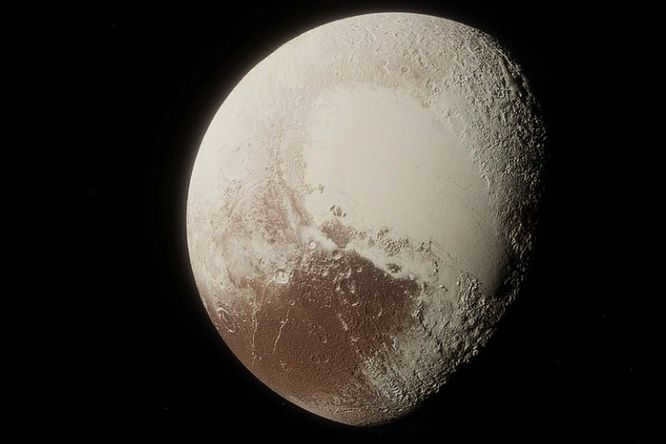
The name Pluto was given to the dwarf planet by Venetia Burney, an 11-year-old girl from Oxford. She suggested to her grandfather that the new world should be named after the Roman god of the underworld. Her grandfather then gave the name to the Lowell Observatory. The name also serves as a tribute to astronomer Percival Lowell, whose initials are the first two letters of Pluto.
What is the appearance of Pluto?
Until 2015, not much was known about the size or conditions on the surface of the dwarf planet Pluto, as it is located so far away from Earth. However, thanks to NASA’s New Horizons space probe, which conducted a close flyby of Pluto, we now have a better understanding. New Horizons discovered that Pluto has a diameter of 2,370 kilometers. The interplanetary probe also captured images of Pluto’s surface, revealing various features such as mountains that reach heights of 3,500 meters, similar to the Rocky Mountains on Earth. Although methane and nitrogen ice cover a significant portion of Pluto’s surface, these substances are not sturdy enough to support such massive peaks. Consequently, scientists believe that these mountains formed on a foundation of water ice.
The dwarf planet also possesses a snake-like icy ridge topography, reminiscent of Earth’s penance or erosion on mountainous terrain. An additional notable characteristic on the surface of Pluto is a vast heart-shaped region, unofficially referred to as Tombaugh Regio (in tribute to Clyde Tombaugh). The left portion of this region (which resembles an ice cream cone) is coated in carbon monoxide. Further discrepancies in the composition of surface materials have been detected within Pluto’s “heart”.
Planet’s Characteristics
Atmospheric Composition: The atmosphere of Pluto is composed mainly of Methane and nitrogen. According to the observations made by New Horizons, it has been found that Pluto’s atmosphere extends up to 1,600 kilometers above its surface. Magnetic Field: It is still uncertain whether Pluto possesses a magnetic field or not. However, the small size and slow rotation of the dwarf planet suggest that it is unlikely to have a significant magnetic field. Chemical Composition: It is believed that Pluto is made up of a combination of 70% rock and 30% water ice. Internal Structure: The internal structure of the dwarf planet is thought to consist of a rocky core surrounded by a mantle of water ice. The surface is covered with various exotic ices like methane, carbon monoxide, and nitrogen ice.
Orbital characteristics of Pluto
Pluto has a highly elliptical orbit that can take it more than 49 times farther from the Sun than Earth. Due to its eccentric orbit, the distance between Pluto and the Sun can vary significantly. Over a span of 20 years, Pluto has even come closer to the Sun than Neptune. This closer proximity to the Sun resulted in the melting of surface ice and the formation of a thin atmosphere, mainly composed of nitrogen with traces of methane.
While Pluto is no longer classified as a planet (it is officially designated as a dwarf planet, as it does not meet all the requirements on the “planet” checklist), it remains an intriguing object of scientific exploration.
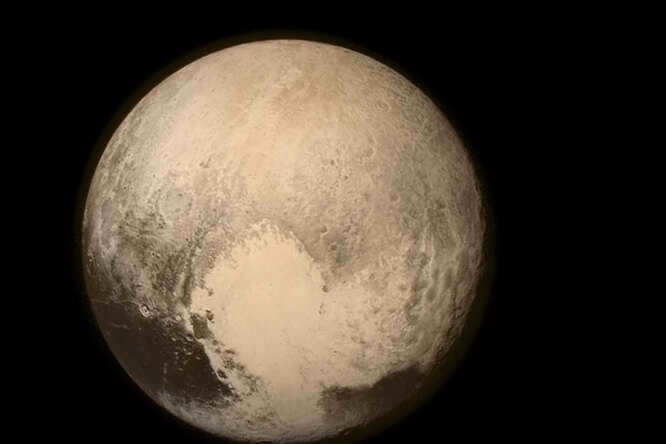
Pluto used to be regarded as the ninth planet in our solar system for a period of 76 years. Its diminutive size, being only half the size of our Moon, did not deter its classification as a planet. Its peculiar oblique oval orbit was also not a hindrance. Despite its eccentricities, Pluto was recognized as a planet.
What led to the reclassification of Pluto as a dwarf planet?
In 2006, the International Astronomical Union (IAU) caused a public outcry by redefining the term “planet” and classifying Pluto as a dwarf planet. This decision was made because Pluto no longer met the criteria set by the new definition. The revised definition stated that a planet must orbit the Sun, have enough mass to form a spheroid shape due to its own gravity, and be capable of clearing its orbit of other objects. Unfortunately, Pluto failed the third requirement, leading to its reclassification as a dwarf planet.
Despite its demotion, Pluto’s geological features are still incredibly fascinating. Perhaps in the future, these unique characteristics could be the key factor in reinstating Pluto as a full-fledged planet within our solar system.
What makes Pluto a unique planet?
Pluto possesses quite a fascinating geology. In 2006, it was discovered that Pluto has an atmosphere, and there is even a possibility of clouds. Additionally, it contains water ice mountains, frozen nitrogen fields, and methane-covered snow-capped peaks. Remarkably, there are also dunes and volcanoes. Such a diverse terrain puts Pluto on par with any rocky celestial body in the inner solar system.
This diverse geology, along with the potential existence of an atmosphere and other characteristics that scientists have determined through the New Horizons spacecraft, could present significant evidence supporting Pluto’s planetary status. The International Astronomical Union (IAU) intends to evaluate all of this information and does not rule out the possibility of reinstating Pluto as a full-fledged planet.
In 2018, a team of researchers from the United States discovered that Pluto’s chemical composition suggests an unconventional origin for this distant celestial body – the collision of multiple comets. Unlike other objects in the solar system, Pluto seems to have formed in a unique way.
Typically, planets are believed to form by accumulating matter from the protoplanetary disk surrounding a young star. However, Pluto’s composition bears a striking resemblance to that of Comet Churyumov-Gerasimenko, particularly the ice covering the Companion Plain. This similarity has led scientists at the Southwest Research Institute in Texas to hypothesize that Pluto may have formed through a different process.
The nitrogen-rich ice covering the Sputnik Plain on Pluto is predominantly composed of nitrogen, with the frigid temperatures on Pluto causing this gas, which comprises 80 percent of Earth’s atmosphere, to solidify. This significant presence of nitrogen can be attributed to the formation of Pluto through the collision of numerous objects, sharing a similar composition to the Churyumov-Gerasimenko comet, as elucidated by planetologist Christopher Glein.
Glaciers composed of nitrogen are responsible for the gradual movement and erosion of the surface of Pluto, erasing elevations and craters. The concentration of nitrogen on this dwarf planet is remarkably high, accounting for up to 98% of its total mass, as estimated by American researchers. Previous theories suggested that the layer of nitrogen ice on Pluto formed from the impact of nitrogen-rich comets, but a revised calculation of the nitrogen quantity challenges this hypothesis.
Scientists have conducted a study on the formation of Pluto and have reached a fascinating conclusion: the dwarf planet primarily obtained its matter from comets, but its composition was also influenced by other factors. It is believed that there may be liquid water, potentially in the form of an ocean, located beneath Pluto’s surface. Additionally, the comet model provides an explanation for another puzzling aspect of Pluto – its relatively low concentration of carbon monoxide compared to other celestial bodies in the solar system. According to this model, all of the carbon monoxide could be contained within Pluto’s interior. On the other hand, the accretionary model struggles to account for the lack of CO, leading the authors of the study to believe that their findings are closer to the truth than those who propose that Pluto formed in the same manner as the other planets in our solar system.
I. Efremov possessed extraordinary intellect, far surpassing his contemporaries by centuries. His predictions, undoubtedly, will materialize. Notably, his description of the fuel anamezon stands out. Its production requires the use of gold. There exist scholarly articles that provide evidence that the Earth is essentially a vast quarry for an unknown entity, with a particular interest in gold. These developments have been unfolding over an extensive period of time, depleting the Earth’s surface reserves to near exhaustion, leaving behind massive dumps and quarries. The question that remains unanswered is why gold, as a metal, was selected as the equivalent of human labor, and whether humans are simply biological machines created solely for the purpose of extracting the Earth’s fossil resources.
However, one must ponder, how exactly do the celestial bodies we now categorize as “comets” differ from the “planetesimals” that gave rise to the remaining planets?
The novel “The Andromeda Nebula” by E. Efremov tells the story of a team of scientists who conducted a thorough investigation of Pluto and reached the conclusion that it is actually a planet of extraterrestrial origin that was captured by our solar system. If the information presented in the article is partially confirmed, it would lend credibility to Efremov’s predictions and generate increased interest in his work.
Firstly, it is a grave mistake for pseudo-scientists to reject Pluto as a “planet”! Regardless of its size, it will always be considered as such by the general public. Secondly, these pseudo-scientists fail to consider the extreme coldness of the outer regions of the solar system. This is precisely why all the nitrogen has frozen! Additionally, the similarity in composition to that of a comet is not a strong enough indicator. On which planet do we observe constant winds? Saturn or Jupiter? This further supports the argument that Pluto’s surface is not easily visible. Perhaps it is not a planet at all, but rather a collection of gases, like a clump. No one has ever been able to explore its interior, except for one satellite, which was unable to observe its “bottom”.
TechInsider Network Edition
Founder of Fashion Press LLC: 119435, Moscow, 12 Bolshoi Savvinsky per. 6, floor 3, room II;
Address of the editorial office: 119435, Moscow, Bolshoi Savvinsky per. 12, p. 6, str. 6, floor 3, room II; Address of the editorial office: 119435, Moscow, Bolshoi Savvinsky per. 6, floor 3, room II;
Chief Editor: Nikita Vasilenok
Email address of the editorial office: [email protected]
Phone number of the editorial office: +7 (495) 252-09-99
Label for information product: 16+
The network edition is registered with the Federal Service for Supervision in the Sphere of Communications, Information Technologies and Mass Media, registration number and date of decision on registration: series EL No. FS 77 – 84123 dated November 09, 2022.





